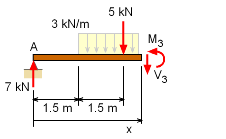| Ch 8. Internal Loads | Multimedia Engineering Statics | ||||||
|
Int. Forces and Moments |
V and M Diagrams I | V and M Diagrams II | V, M, Load Relationships | ||||
| Shear and Moment Diagrams I | Case Intro | Theory | Case Solution | Example |
| Chapter |
| 1. Basics |
| 2. Vectors |
| 3. Forces |
| 4. Moments |
| 5. Rigid Bodies |
| 6. Structures |
| 7. Centroids/Inertia |
| 8. Internal Loads |
| 9. Friction |
| 10. Work & Energy |
| Appendix |
| Basic Math |
| Units |
| Sections |
| Search |
| eBooks |
| Dynamics |
| Fluids |
| Math |
| Mechanics |
| Statics |
| Thermodynamics |
| Author(s): |
| Kurt Gramoll |
| ©Kurt Gramoll |
| Statics- Example |
||
|
Example |
|
Draw the shear and moment diagram for the beam shown in figure. |
||
| Solution |
||
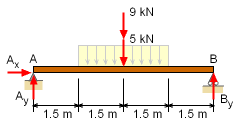 Beam Free-body Diagram |
Before the shear and moment can be determined at any internal location, the boundary conditions need to be calculated. There will be three possible reactions at A and B namely Ax, Ay and By. To calculate them, the distributed load is converted into an equivalent point load of (3 kN/m) (3 m) = 9 kN which is located 3 m from support A as shown in the diagram. The unknown reactions can be found by applying the three standard equilibrium equations. Taking moments about support A and assuming counter clockwise (CCW) moment as positive gives, ΣMA = 0 Equating vertical forces gives, ΣFy = 0 Since there is no horizontal applied load, Ax will be zero. (Reaction forces can also be calculated by dividing sum of forces acting on the beam by 2, since the beam and loading are symmetrical.) |
|
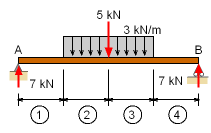 Beam Sections |
Since the beam has forces acting at four locations, the shear and moment needs to be analyzed in four different sections. The shear and moment may not be continuous across a load or support. Each section needs to be cut and analyzed for shear and moment as a function of x from the left edge. The results can then be plotted and the maximum shear and moment can be easily identified. | |
| Section 1 | ||
 Section 1 |
To find the shear and moment in section 1, cut the beam at an arbitrary point x in section 1 and then draw a free-body diagram as shown on the left. Next, sum the forces to give, ΣFy = 0 Summing the moments about the cut edge gives, ΣMcut = 0 It should be noted that these results are only good for section 1 (0 ≤ x ≤ 1.5 m). | |
| Section 2 | ||
 Section 2 |
Section 2 is between the start of distributed load and the point load. Again, cut the beam at an arbitrary point x in section 2 and then draw a free-body diagram as shown on the left. Sum the forces to give, ΣFy = 0 Summing the moments about the cut edge gives, ΣMcut = 0 These results are only good for section 2 (1.5 ≤ x ≤ 3m). To assist in graphing the shear and moment equations, the exact values can be calculated at each end of the beam section. When x = 1.5,
the shear force will be, When x = 3, the shear force will be, |
|
| Section 3 | ||
|
Section 3 is between point load of 5 kN and end of universal distributed load. The free-body diagram for the beam will be as shown on the left. Sum of the forces gives, ΣFy = 0 Summing the moments about the cut edge gives, ΣMcut = 0 These results are only good for section 3 (3 ≤ x ≤ 4.5m). When x = 3,
the shear force will be, When x = 4.5,
the shear force will be,
|
|
| Section 4 | ||
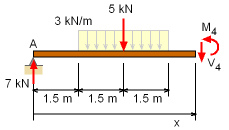 Section 4 |
The final cut is at the far right section of the beam. The free-body diagram for the beam will be as shown on the left. Sum of the forces gives, ΣFy = 0 Summing the moments about the cut edge gives, ΣMcut = 0 These results are only good for section 3 (4.5 ≤ x < 6m). When x = 4.5,
the shear force will be, When x = 6, the shear force will be, |
|
| Shear and Moment Diagrams | ||
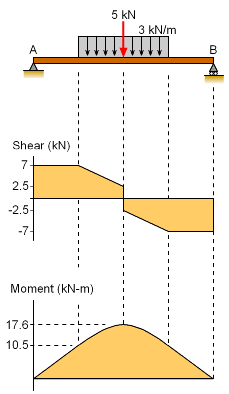 |
Now that the shear and moment is known for each section of the beam, the results can be plotted. The resulting graphics are called the shear diagram and moment diagram. Since the same x was used for all three sections, the each equation for each section can be easily plotted as shown at the left. Since beam and loading are symmetrical, shear force diagram and bending moment diagram can also be drawn by solving first 2 sections only. For shear moment diagram other half will be anti-mirror image of first 2 sections and for bending moment diagram other half will be mirror image of first 2 sections which can be seen in the figure shown on the left. |
|
Practice Homework and Test problems now available in the 'Eng Statics' mobile app
Includes over 500 free problems with complete detailed solutions.
Available at the Google Play Store and Apple App Store.

